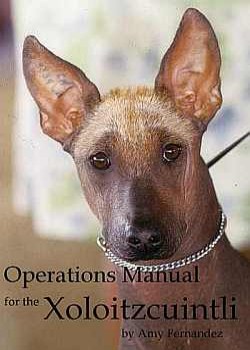2012 Edition. This book has been revised, and now includes many more photos.
The complete, illustrated, guide to the Xoloitzcuintli, for judges, breeders and owners, featuring color photos and B&W line drawings.
This e-book provides an illustrated, in depth examination of the Xoloitzcuintli breed against the standards that apply in its home country of Mexico, and as used by the American Xolo club.
Xolo owner, breeder, and judge, Amy Fernandez, has many years of experience in this breed, and has judged the Mexican Xoloitzcuintli specialty show in Tijuana.
Also a highly experienced author and journalist, Amy has, with this book, created the serious Xolo lovers bible.

CONTINUITY OF CONSTRUCTION AND EVOLUTION OF TYPE
Selective breeding sometimes seems more complicated for hairless breeds, but in reality, the same rules apply. The hairless mutation represents just one facet of the process. Mutations—spontaneous genetic changes—are the ultimate source of genetic variation. Without them, evolution, or selective dog breeding, would not be possible.
Natural selection forms a species to fulfil a specific function. It is the breeder’s job to apply the same principles to artificial selection. No matter which selective process is directing a breed’s evolution, exactly the same genetic laws apply to the same thirty-nine pairs of chromosomes.
Random breeding and outcrossing will provide a temporary barrier to health problems, but this approach will never offer any control or predictability to influence the type of dog you are producing. These dogs may be healthy, but the tradeoff is complete unpredictability in conformation, behavior, and genetic health.
By understanding the transmission of various breed traits, you can create a bloodline that will predictably conform to your expectations. Most of the genetic traits that we are seeking readily respond to straightforward selection. Decisions that you make for your breeding program may demonstrate results in one generation, will likely show results in the second and become predictably set into your line by the third.
The first and most important step in breeding is a clear understanding of the elements of type that define your breed. Form follows function; this concept provides a logical framework by which to evaluate every trait.

